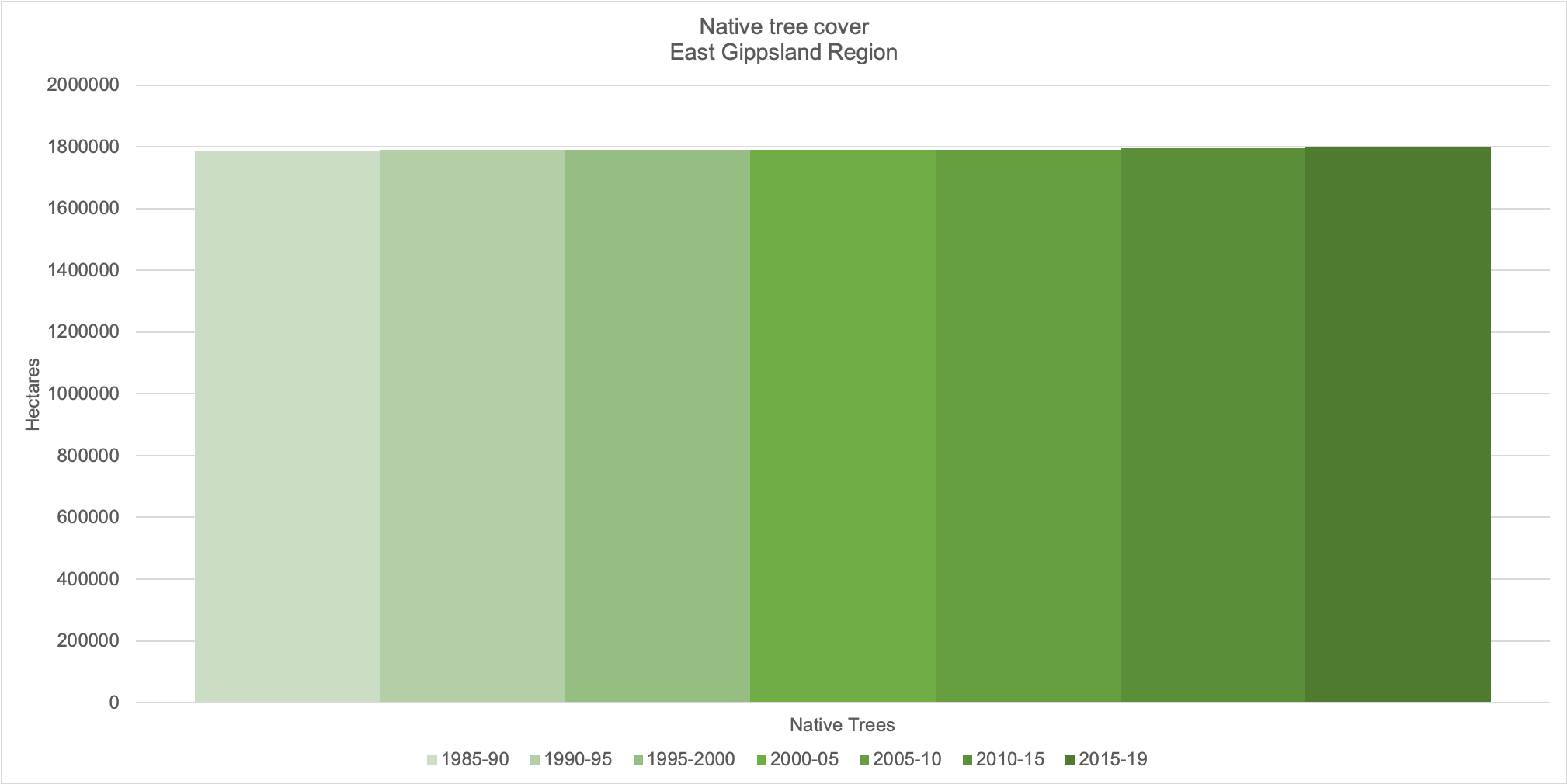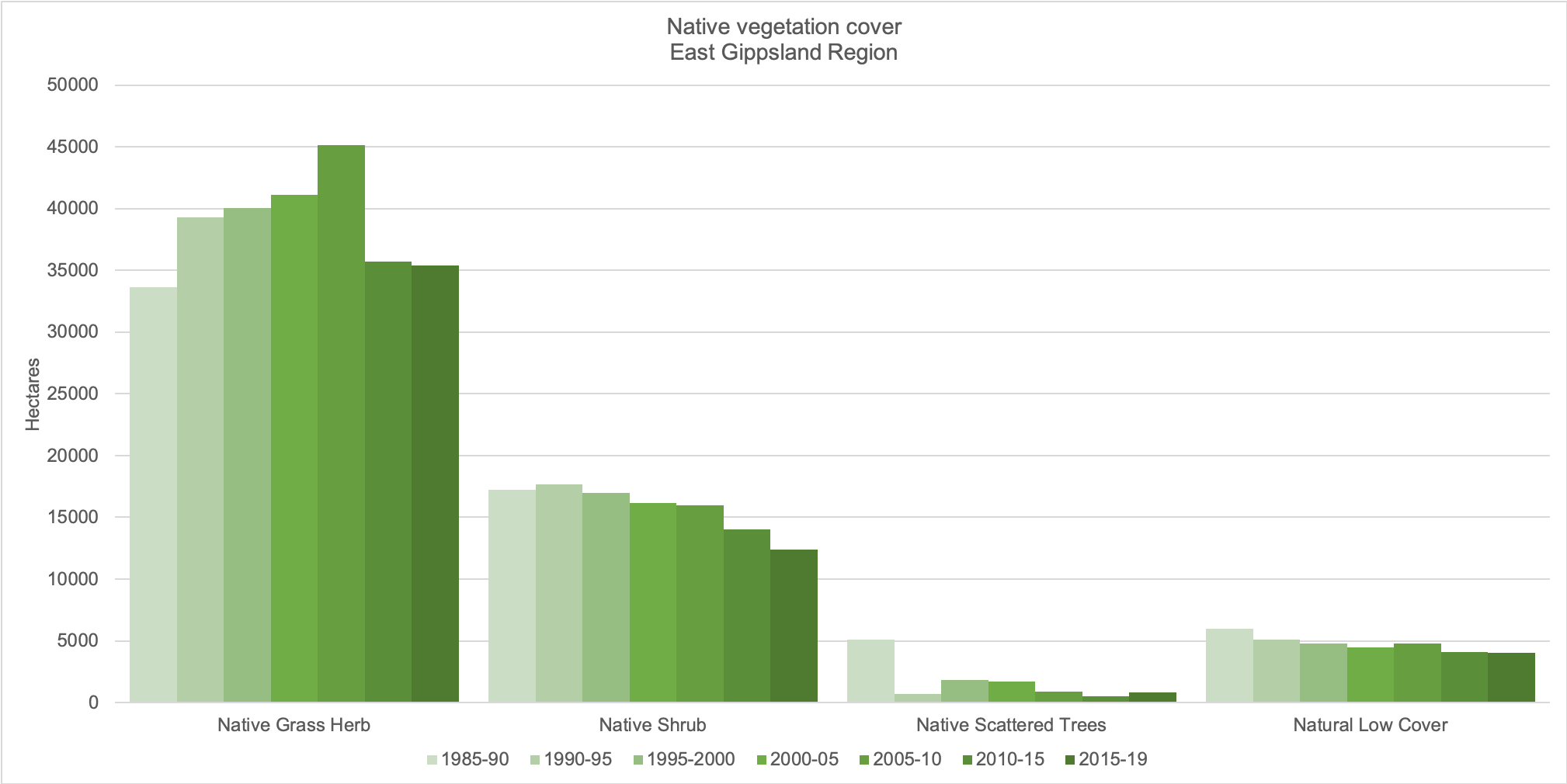The ‘biodiversity theme’ of this Regional Catchment Strategy includes the terrestrial plant and animal species, and the habitats that support them. The biodiversity of East Gippsland is unique to our region and important for us all.
Our biodiversity values… a snapshot
East Gippsland is a biodiverse region bounded by the peaks of the Great Dividing Range to the north, where mountain peaks rise to 1870 metres and extending to the coastal and marine environments in the south.
Our region supports significant biodiversity values. It is one of the few places in Victoria to retain the majority (around 80 %) of pre-European extent of native vegetation cover. Around 83 % of the region is in public ownership, mainly as state forests, national and coastal parks.
These intact habitats support a many different plants and animals, with records of over 5000 species. This includes at least 35 species of plant that are unique to the region.

East Gippsland is one of the few places in Victoria to retain a high degree of native vegetation, with over 80% of pre-European extent of native vegetation cover. While there has been clearing of Plains Grassy Woodland and Forest in the lower floodplains, particularly in the west of the region, a high proportion of rainforest (97%) and dry forests (96%) have been retained.

There are at least 13 Commonwealth or State listed threatened ecological communities supported in East Gippsland, these include:
- Alpine sphagnum bogs and associated fens – endangered (EPBC); FFG listed
- Gippsland Red Gum Grassy Woodland and associated native grassland – critically endangered (EPBC)
- Seasonal Herbaceous Wetlands of the Temperate Lowland – critically endangered (EPBC)
- Littoral Rainforest and Coastal Vine Thicket – critically endangered (EPBC)
- Subtropical and Temperate Coastal Saltmarsh – vulnerable (EPBC)
- White Box-Yellow Box-Blakely’s Red Gum Grassy Woodland and derived Native Grassland – critically endangered (EPBC)
- Forest Red Gum Grassy Woodland Community – FFG listed
- Warm Temperate Rainforest (Coastal East Gippsland) Community – FFG listed
- Warm Temperate Rainforest (Cool Temperate Overlap, Howe Range) Community – FFG listed
- Warm Temperate Rainforest (East Gippsland Alluvial Terraces) Community – FFG listed
- Warm Temperate Rainforest (Far East Gippsland) Community – FFG listed
- Cool Temperate Rainforest – FFG listed
- Cool Temperate Mixed Forest – FFG listed”
Figure 1: East Gippsland vegetation communities
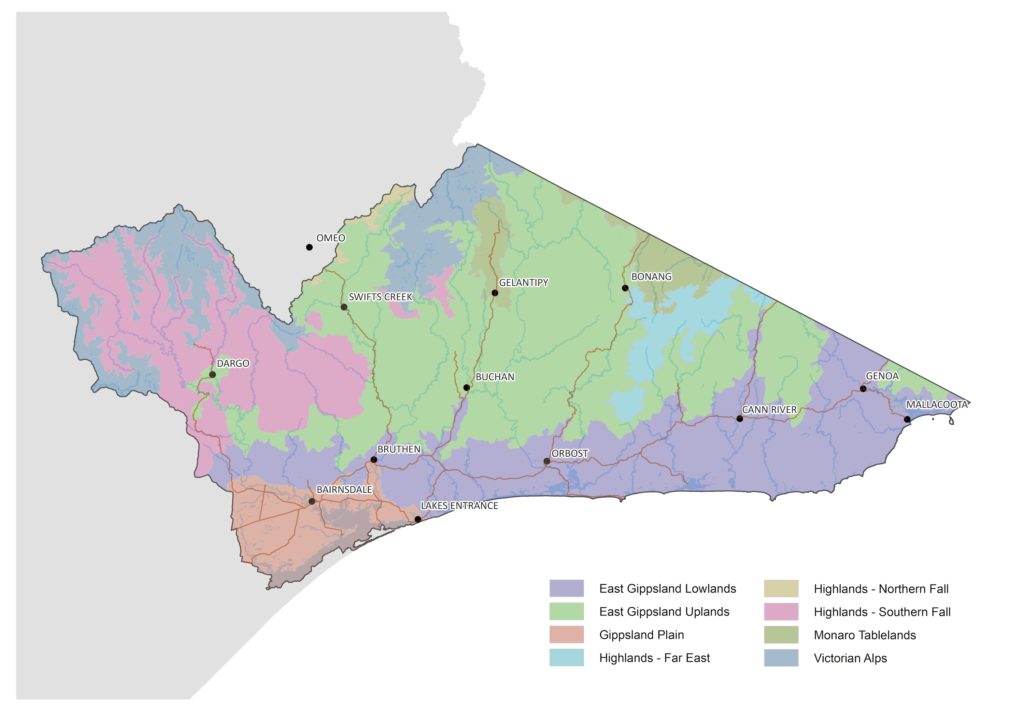
The Atlas of Living Australia has records of 140 EPBC listed threatened species from the East Gippsland region. This includes 60 species of plant, 30 species of bird, 18 species of mammal, 11 species of fish, eight species of reptile, seven species of frog and a number of invertebrates.
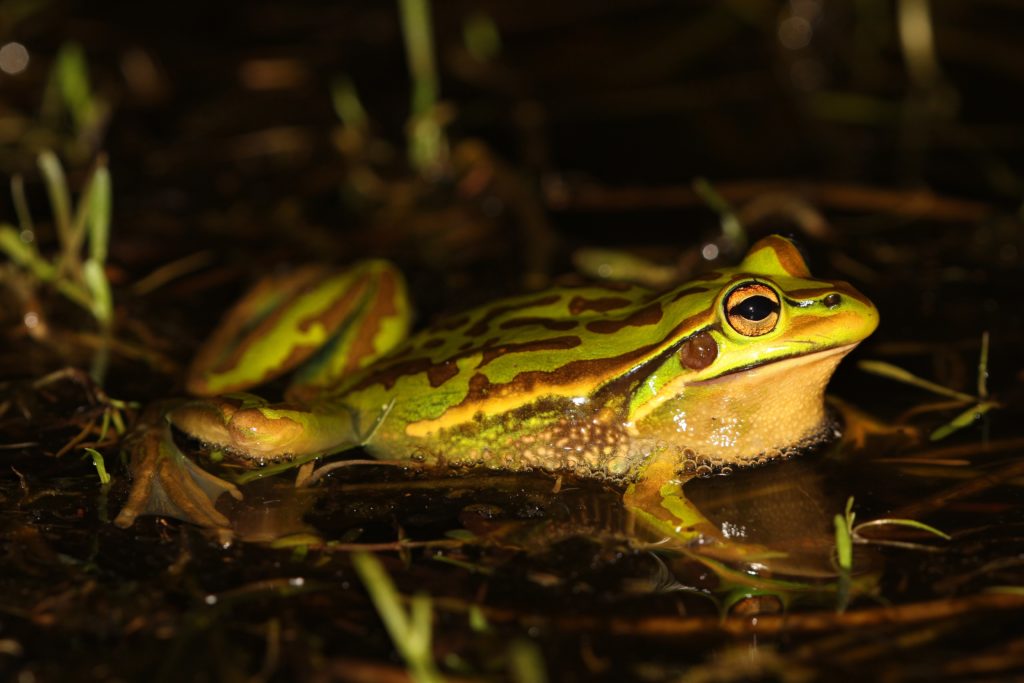
In addition, 1100 species that are considered rare or threatened in Victoria have also been recorded within the region. This list includes 11 species that are known to only occur in East Gippsland including several plants and three species of galaxiid native fish.
East Gippsland supports greater than 50% of the Victorian range of 17 species listed as endangered or vulnerable nationally and a further 40 species listed as threatened in Victoria (Table 1).
Table 1: Threatened species for which East Gippsland represents > 50% of the Victorian range
EPBC - Environment Protection and Biodiversity Conservation Act, 1999
FFG - Flora and Fauna Guarantee Act, 1988
E - Endangered, V - Vulnerable, ce - critically endangered, e - endangered, v - vulnerable
(https://www.environment.vic.gov.au/conserving-threatened-species/threatened-list)
| Plants | Scientific name | FFG | EPBC | Animals | Scientific name | FFG | EPBC |
|---|---|---|---|---|---|---|---|
| Bantam bush-pea | Pultenaea parrisiae | V | Giant burrowing frog | Heleioporus australiacus | Critically endangered | V | |
| Betka bottlebrush | Callistemon kenmorrisonii | Critically endangered | V | Green and golden bell frog | Litoria aurea | V | |
| Black stem | Adiantum formosum | Critically endangered | Keferstein’s tree frog | Litoria dentata | Critically endangered | ||
| Buff hazelwood | Symplocos thwaitesii | Critically endangered | Large brown tree frog | Litoria littlejohni | Critically endangered | V | |
| Cabbage fan-palm | Livistona australis | Critically endangered | Martin’s toadlet | Uperoleia martini | Critically endangered | ||
| Colquhoun grevillea | Grevillea celata | Critically endangered | V | Black bittern | Ixobrychus flavicollis | Endangered | |
| Cotoneaster pomaderris | Pomaderris cotoneaster | Critically endangered | E | Eastern bristlebird | Dasyornis brachypterus | Critically endangered | E |
| Dainty bitter-cress | Cardamine tryssa | Critically endangered | Glossy black-cockatoo | Calyptorhynchus lathami | Critically endangered | ||
| Deddick blue-box | Eucalyptus baueriana subsp. deddickensis | Critically endangered | Masked owl | Tyto novaehollandiae | Critically endangered | ||
| Forrester’s bottlebrush | Callistemon forresterae | Endangered | V | Dargo galaxias | Galaxias mungadhan | Critically endangered | |
| Genoa River correa | Correa lawrenceana var. genoensis | Critically endangered | E | East Gippsland galaxias | Galaxias aequipinnis | Critically endangered | |
| Genoa spider-orchid | Caladenia ancylosa | Critically endangered | V | Mcdowells galaxias | Galaxias mcdowalli | Critically endangered | |
| Gippsland banksia | Banksia croajingolensis | Critically endangered | Clayton’s spiny crayfish | Euastacus claytoni | Endangered | ||
| Green wattle | Acacia irrorata subsp. irrorata | Critically endangered | East Gippsland spiny crayfish | Euastacus bidawalus | Vulnerable | ||
| Heath spider-orchid | Caladenia peisleyi | Endangered | Mallacoota burrowing crayfish | Engaeus mallacoota | Critically endangered | ||
| Kosciuszko grevillea | Grevillea victoriae subsp. nivalis | Endangered | Orbost spiny crayfish | Euastacus diversus | Endangered | ||
| Kydra dampiera | Dampiera fusca | Critically endangered | Brush-tailed rock-wallaby | Petrogale penicillata | Critically endangered | V | |
| Lemon-scented zieria | Zieria citriodora | V | Long-footed potoroo | Potorous longipes | Endangered | E | |
| Long-leaf bitter-pea | Daviesia wyattiana | Critically endangered | Long-nosed potoroo | Potorous tridactylus trisulcatus | Vulnerable | E | |
| Maiden’s wattle | Acacia maidenii | Critically endangered | Diamond python | Morelia spilota spilota | Critically endangered | ||
| Marsh leek-orchid | Prasophyllum niphopedium | Endangered | |||||
| Mountain cryptandra | Cryptandra speciosa subsp. speciosa | Critically endangered | |||||
| Mt Stewart wax-flower | Philotheca myoporoides subsp. petraea | Critically endangered | |||||
| Narrow-leaf bent-grass | Deyeuxia pungens | Critically endangered | V | ||||
| Olive mallee | Eucalyptus elaeophloia | Vulnerable | |||||
| Orange-blossom orchid | Sarcochilus falcatus | Critically endangered | |||||
| Purple eyebright | Euphrasia collina | Critically endangered | |||||
| Rock mallee | Eucalyptus saxatilis | Vulnerable | |||||
| Snowy river westringia | Westringia cremnophila | Endangered | V | ||||
| Stringybark tea-tree | Leptospermum jingera | Endangered | |||||
| Suggan Buggan wax-flower | Philotheca myoporoides subsp. brevipedunculata | Critically endangered | |||||
| Tasmanian wax-flower | Philotheca virgata | Endangered | |||||
| Thyme pink-bells | Tetratheca thymifolia | Vulnerable | |||||
| Upright pomaderris | Pomaderris virgata | Critically endangered | |||||
| Viscid daisy-bush | Olearia viscosa | Critically endangered | |||||
| Willow needlewood | Hakea macraeana | Critically endangered | |||||
| Wooly-bear wattle | Acacia lucasii | Critically endangered | V |
The high proportion of public land and retention of much of the native vegetation and habitats of the region, means that much of the biodiversity of East Gippsland is exposed to lower levels of threat from changed land use than elsewhere in Victoria.
In the lowlands and regions cleared for agricultural production, habitats can become fragmentated, whilst pressures from recreational impacts from tourism and recreational pursuits can affect species and habitats, particularly in popular seaside destinations.
Over much of the rest of the East Gippsland region threats to biodiversity arise from:
Climate change
Increased hot and dry conditions will mean an increase in the frequency and severity of bushfires. If fires occur more frequently than habitats and animal populations can recover, then long term impacts to population viability can be expected. In 2019−20, bushfires affected over 56% of the East Gippsland region, burning a large proportion of the native vegetation and killing or displacing large numbers of animals. The full extent of the impact and recovery from this event is not yet fully understood. A range of bushfire recovery programs have been implemented following the fires.
Alpine areas are highly vulnerable to climate change impacts with reduced snowfall and an increase in the altitude of snow fall. Plants that require periods of chilling to complete lifecycles may not survive.
Many of the impacts to flora and fauna are difficult to predict exactly, although it is expected that gradual changes in temperature and rainfall may see changes in the composition of vegetation communities as more resilient species cope in a warmer and drier climate. There may be an increase in pest plants and animals that are more adaptable to changing conditions. Fauna species may experience changes in behaviour, abundance and distribution as well as potential shifts in regular cycles such as migration or breeding.
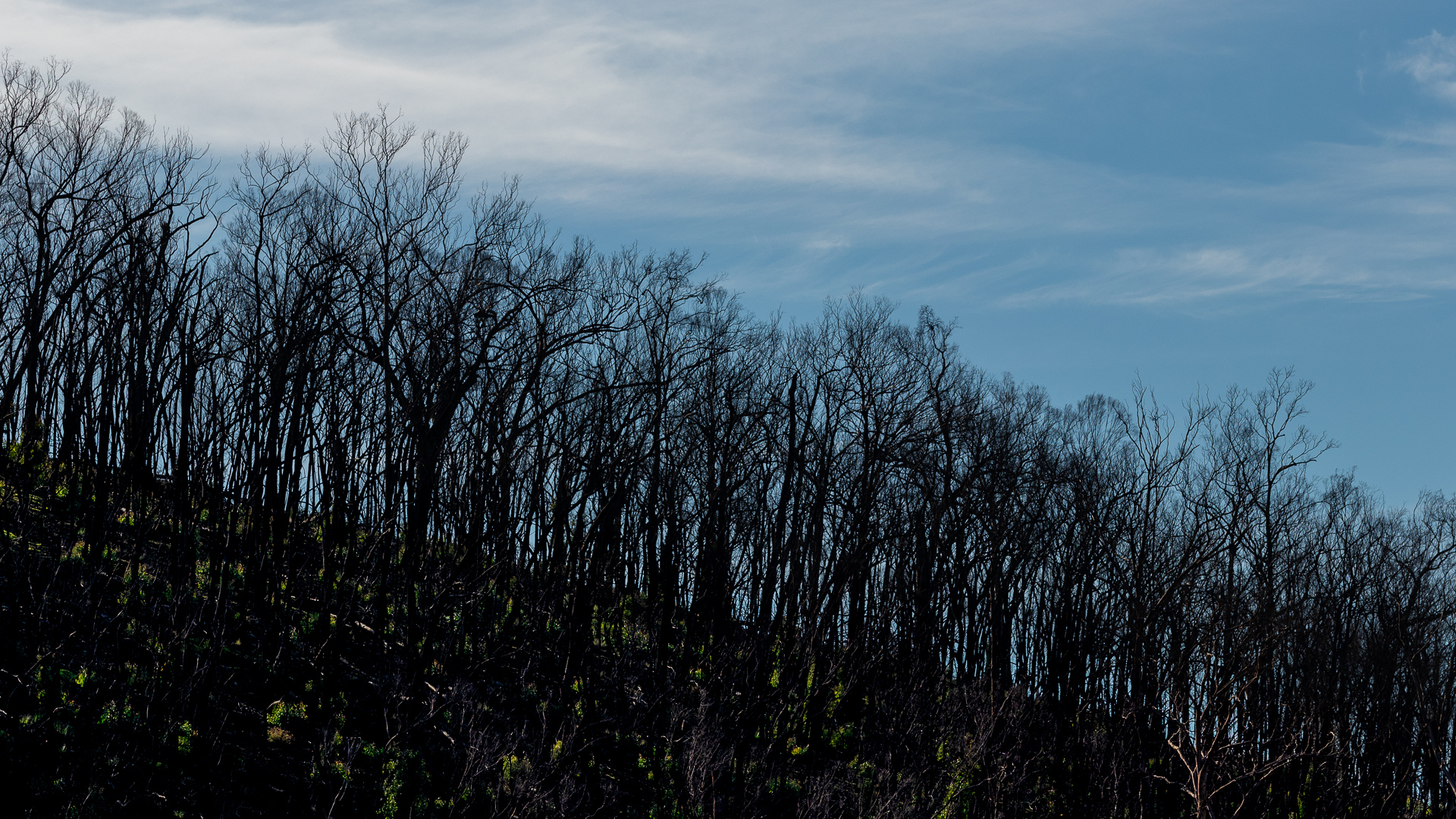
Pest plants and animal
Despite much of East Gippsland retaining native vegetation cover, there are still areas of priority weeds and a number of significant pest animal threats to biodiversity.
- Weeds have the potential to transform important vegetation communities and natural systems, drastically altering their form and function. Riparian weeds like willows have to potential to invade waterways, outcompeting native species, altering water temperature and chemistry, and changing the physical form of streams. Climbing and or shade tolerant weeds can impact rainforest communities, impacting canopy trees and out competing native groundcover species. In coastal ecosystems salt tolerant invasive plants can spread across wide areas of the wild coastlines in East Gippsland altering sand movement and dune formation, and outcompeting native species that stabilise our coastline.
- Horses remain a significant threat in alpine areas. Damage to vegetation communities (including threatened communities and species) is a common impact through overgrazing and trampling, which leads to erosion and water quality impacts to fragile ecosystems such as wetlands and peatlands in alpine areas, particularly where horse numbers are high.
- Deer are a significant threat across all landscapes in the region causing damage to vegetation communities, threatened plant species and resulting in loss and degradation of habitat for native animals. Deer have the potential to severely impact alpine wetlands and streams, stands of rainforest, and fragile coastal systems through their browsing, rubbing and wallowing behaviours.
- Pigs also represent a significant threat, particularly in the Upper Snowy, Cobberas and Monero Tablelands. In these areas impacts are greatest in alpine peatlands due to upturning of soils and subsequent weed invasion, and the risk of incursions from cross border areas is ongoing particularly along the Snowy River corridor.
- Introduced predators such as foxes and cats remain a threat to wildlife including birds, frogs, reptiles and native mammals and the ecosystems that these native species influence (for example the role of potoroos as ecosystem and soil engineers, and quolls as native predators). predators can significantly impact on population of resident and migratory shore and water birds along our coast and estuaries, and continue to impact critical weight range mammals the forested areas across East Gippsland.
Area of permanent protection
The East Gippsland region contains over 1.8 million hectares under permanent protection (Table 2). This represents over 60% of the total area within the region. National Park comprises approximately 90% of the protected area, covering more than 1.6 million hectares.
Table 2: Area of permanent protection in East Gippsland.
Source: Collaborative Australian Protected Area Database (CAPAD)
| Protection type | Number of protected areas | Proportion of total protected area (%) | Total area (ha) | Additional area (ha) since 2017 |
|---|---|---|---|---|
| National Park | 10 | 89.5% | 1,638,677 | 0 |
| State Park | 1 | < 1% | 8,695 | 0 |
| Conservation covenant and other private lands | 118 | < 1% | 5,306 | 367 |
| Other (including other public land reserves e.g. natural feature reserves, nature conservation reserves, heritage rivers) | 213 | 9.70% | 177,362 | 0 |
Native vegetation cover
Extent of native vegetation across the East Gippsland region is very high, with almost 1.8 million hectares of tree cover, 35,000 hectares of native grassland and 10,000 hectares of native shrubs. In the period between 1985 and 2019 there had been little change in tree cover, although the 2019-20 bushfires will have impacted this significantly, which is not accounted for in the available landcover data (Figure 2).
Figure 2: Change in extent of native tree cover (hectares) in the East Gippsland Region.
Source: Victorian Land Cover Time Series (DELWP)
There had been a steady increase in native grassland between 1985 and 2010, but a subsequent decline to 1985 benchmark levels. There has also been a slight decline in native shrub and natural low cover vegetation in the past two decades (Figure 3).
Figure 3: Change in extent of native vegetation cover (hectares) in the East Gippsland Region.
Source: Victorian Land Cover Time Series (DELWP)
Protecting Victoria’s Environment – Biodiversity 2037 and the regional Biodiversity Response Planning process
Victoria’s biodiversity, including native flora and fauna and their habitats, has been declining since European settlement. Victoria has lost around 80 species, and between one quarter and a third of all of Victoria’s terrestrial plants, birds, reptiles, amphibians and mammals, along with numerous invertebrates and ecological communities, are considered to be at threat of extinction. Climate change and population growth are expected to exacerbate existing threats and bring new challenges for Victoria’s biodiversity (Protecting Victoria’s Environment – Biodiversity 2037, DELWP 2017).
Biodiversity 2037 Protecting Victoria’s Environment is Victoria’s 20-year plan to stop the decline of native plants and animals and improve the natural environment. Biodiversity 2037 sets targets for management outputs (including weed control in priority locations) that contribute to biodiversity outcomes and the goal ‘Victoria’s natural environment is healthy’.
Under Biodiversity 2037, the Biodiversity Response Planning (BRP) process is a long-term area-based planning approach to biodiversity conservation. It is designed to strengthen alignment between agencies, Traditional Owners and the community by working together to identify, promote and tackle local biodiversity needs as part of an ongoing collective process. The regional BRP process identifies Focus Landscapes and the priority actions for these landscapes drawing on stakeholder input, local knowledge and modelling. There are eight focus landscapes in East Gippsland region.
More information on the region’s biodiversity values and actions to protect biodiversity is available via a set of fact sheets for Biodiversity Response Planning focus landscapes. The fact sheets can be used to provide direction on what on-ground activities would be highest priority to do to get the best biodiversity result.

Biodiversity – Regional Outcome Targets
These regional outcomes relate to the biodiversity theme within the RCS. They set out the long term (to 2040) and medium term (to 2027) outcomes as they relate to the region’s biodiversity assets. The outcomes include those aligned with the statewide outcomes framework (in italics) as well regionally specific outcomes developed in collaboration with RCS partners.
The RCS outcomes framework can be found here, and more detailed outcomes addressing each theme of the RCS and linked closely to each of the local areas can be found here. Details on specific management actions to be implemented within individual landscapes, and the local stakeholders that will contribute to their delivery is provided in the Local Areas section.
Medium-term
Outcomes (2027)
Increase the area of native vegetation under permanent protection by an additional 1500 ha# focussing on improving the condition of and connectivity to existing remnants.
Increase the area and diversity of native vegetation through re vegetation of an additional 5000ha# focusing on improving the condition of and connectivity to existing remnants in priority locations.
Integrated large herbivore control (deer, horses, pigs) is implemented in priority locations over 640,000 ha# to protect and maintain important biodiversity values.
Threatened Ecological Communities and priority vegetation types are maintained through implementation of 308,000 ha# of sustained weed control in priority locations.
Threatened animals are protected through sustained integrated predator control in 480,000 ha# of priority locations.
Sustained predator control has been implemented 35,000 ha# of known priority waterbird foraging and breeding sites.
Long-term
Outcomes (2040)
Populations of threatened species and ecological communities are maintained.
Recovery trajectory of East Gippsland forests is well understood and being observed across areas impacted by fire.
# These outcomes contribute to the regional targets and priority locations established through Biodiversity 2037 and TfN’s provisional targets for permanent protection on private land. They represent a realistic level of ambition for key partners. Progress reporting against the outcomes will also consider activities related to the implementation of the RCS in other priority locations informed by other regional planning and prioritisation processes.
Regional targets established through Biodiversity 2037 are as follows:
By 2037
Total area permanently protected since 2017 – 35,000 ha
Total area in priority locations under sustained weed control* – 385,000 ha
Total area of revegetation in priority locations for habitat connectivity since 2017 – 10,000 ha
Total area in priority locations under sustained herbivore control* – 800,000 ha
Total area in priority locations under sustained pest predator control* – 640,000 ha.
* Hectares (ha) annually
“Priority locations” in relation to the medium term outcomes and Biodiversity 2037 targets, are determined by the latest version of SMP (currently v3).

